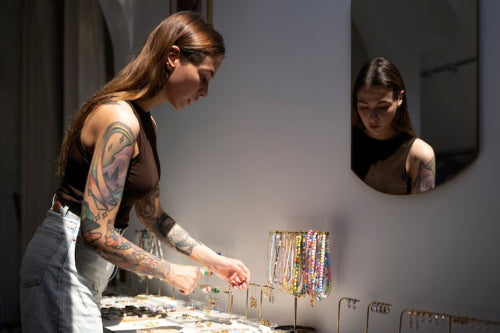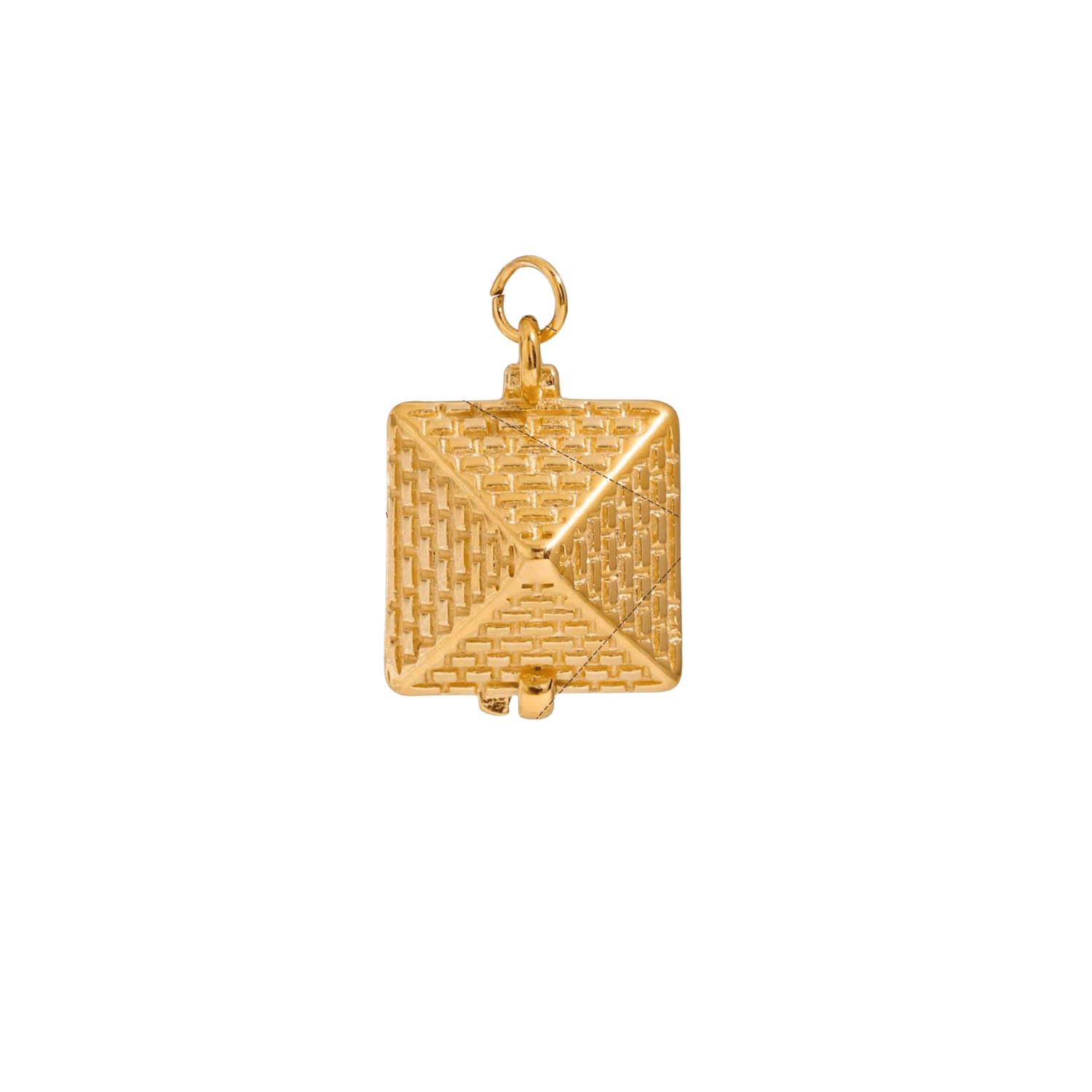
The Influence of Art and Architecture on Jewelry Design Trends
Share
In the heart of Jaipur's crowded jewelry market, a designer hunches over her sketchpad, tracing the lattice patterns of the Hawa Mahal that breezy palace facade known as the "Palace of Winds." Her pendant design fuses age-old techniques with a sleek, modern twist, embodying a worldwide surge in jewelry that whispers tales of history, artistry, and built wonders. From India's lively bazaars to upscale shops in Manhattan, creators are delving into yesteryears to craft tomorrow's treasures, embedding structural elements into accessories that strike a chord with discerning buyers. This blend of legacy and novelty is transforming jewelry creation, showing that personal embellishment can embody cultural depth as much as aesthetic appeal.
Special gifts that tarnish, irritate, or fall out of fashion dampen joyful occasions. That disappointment clouds memories meant to endure. Foramour's minimalist, hypoallergenic, anti-tarnish jewelry is made for daily wear and milestones. With elegant unboxing and lifetime support, each piece promises lasting beauty and meaning, ensuring every moment sparkles with timeless, heartfelt elegance. Shop Now!
India's Enduring Artistic Influence on Modern Jewelry
India stands as a dominant force in the global jewelry market, mirroring its vibrant weave of artistic and architectural traditions. A recent analysis estimates the worldwide jewelry industry at roughly USD 366.79 billion in 2024, poised for expansion to USD 578.45 billion by 2033, with a steady compound annual growth rate of 5.3% between 2025 and 2033. This expansion stems mainly from higher disposable earnings, shifting style preferences, and a rising appetite for upscale, custom-made items. The Asia Pacific region captured the biggest portion in 2024 at 60.2%, while the United States dominated North America's sector with a 92.6% revenue slice. Among products, rings commanded the top spot with 33.8%, and gold items led materials with 54.9%. Yet, beneath these figures unfolds a richer narrative: Indian jewelry transcends mere decoration, serving as a medium for cultural storytelling.
The architectural splendor of India, from Mughal palace filigrees to South Indian temple sculptures, offers endless inspiration for jewelers. In regions like Tamil Nadu and Karnataka, motifs such as blooming lotuses and divine dancers are reborn in golden chains and studs, tailored for today's brides and holiday celebrants. Rajasthan's fort jali screens and vivid Mughal-inspired enamel techniques are evolving into bold statement jewelry. These creations do more than market products; they forge links to India's illustrious history, attracting city sophisticates and international enthusiasts alike.
To deepen this cultural tie, many designers draw from specific landmarks. For instance, the Taj Mahal's symmetrical inlays influence pearl and gem settings, while the stepwells of Gujarat inspire geometric pendant forms. This approach not only preserves traditional skills but also adapts them for global tastes, ensuring Indian jewelry remains relevant in a fast-changing world.
A Worldwide Movement Rooted in Indian Aesthetics
Architectural impacts on jewelry extend beyond India's borders, forming a global movement infused with Indian flair. Coverage in Elle Decor of Taylor Swift's engagement ring, crafted by Kindred Lubeck at Artifex Fine Jewelry, spotlights this shift. The ring boasts an antique-style old mine-cut diamond, roughly 8 to 13 carats, set in yellow gold with intricate hand-engraved filigree echoing the lavish details of Georgian and Victorian times, which parallel India's ornate maximalism. This choice signals a widespread craving for genuine craftsmanship, akin to the boom in hand-painted furnishings and distinctive tiles in home design. It appears fashion and decor are uniting in their appreciation for enduring, yet innovative, artistry.
Within India, powerhouses like Tanishq spearhead this evolution. Their Utsaah collection, drawing from South Indian temple structures, has emerged as a holiday staple, merging robust gold work with elements like towering gopurams and sacred mandalas. The line employs techniques such as contemporary filigree, enamel, and jaali over stones, breathing fresh life into heritage designs. Likewise, Amrapali Jewels in Jaipur channels Rajputana architecture, producing items that wed ancient majesty with current sophistication. Founded on a passion for ancient India, the brand integrates Mughal, Rajput, and tribal patterns into modern pieces. These offerings appeal to wealthy urbanites and overseas Indians, viewing jewelry as both asset and heritage emblem.
Partnerships further this trend, like those involving Tribe by Amrapali, which infuses tribal motifs, gemstones, and enamel into bohemian-inspired collections. Collaborations with brands like FabIndia introduce Mughal-style meenakari to youthful city dwellers, demonstrating that tradition can align with contemporary cool. Expanding on this, designers are exploring lesser-known influences, such as the cave paintings of Ajanta for organic shapes or Hampi's ruins for textured surfaces, broadening the appeal.
Sustainable Practices and Creative Advances in Jewelry Making
With changing buyer priorities, the substances and processes in these designs are evolving too. The luxury fine jewelry segment anticipates consistent expansion from 2025 to 2035, spotlighting premium, custom pieces emphasizing ethical diamonds, uncommon gems, and eco-friendly materials mirroring the call for accountable luxury. Leading brands address high-end desires via AI-based personalization, blockchain verification, and engaging store encounters. The market is forecasted at USD 51.83 billion in 2025, climbing to USD 92.83 billion by 2035, with a 6.0% compound annual growth rate. Spending per person on such jewelry mirrors economic strength and cultural love for elite adornments, focused among the wealthy but shaped by demographics, wealth spread, and shopping access. This category encompasses top-tier diamond rings, gem necklaces, and gold from renowned labels, symbolizing prestige, custom, and value storage.
Designers increasingly opt for reused metals and synthetic stones, rooted in India's classic architecture yet made with today's morals. In Varanasi, groups of craftsmen, backed by the Skill India initiative, safeguard meenakari methods while tweaking them for green-minded purchasers. These steps support a worldwide drive for ethical luxury, boosting clarity and tailoring through tech.
However, obstacles remain. Reports from the National Skill Development Corporation highlight a worrisome pattern: younger craftspeople are ditching ancestral trades, endangering skills like temple jewelry creation. Attrition rates hover at 5-10% in manufacturing, spiking to 25-30% in retail, fueled by health risks from chemicals, poor conditions, and low pay relative to effort. Workers often retire early, around 40-45, due to ailments, halting skill transmission. The field struggles with shortages in metalworking, design, and quality checks, plus a mistrust between trainers and industry. Elevated costs for handmade patterns restrict access for budget-conscious buyers in smaller towns. While structural motifs aid upscale positioning, oversaturation risks endless lotus or jali items could curb creativity. Safeguarding native designs against misuse poses another issue, with international firms often adopting without acknowledgment.
To counter these, initiatives focus on better training and safety. For example, addressing health concerns could retain talent, while digital tools might bridge skill gaps, ensuring the sector's vitality.
Growth Prospects and International Allure
Amid hurdles, vast potential exists. India's gems and jewelry exports reached about US$ 35.98 billion in FY23, per the Gem & Jewellery Export Promotion Council and IBEF data, set to benefit from heritage-highlighting lines. Architectural elements provide a distinct edge, letting brands cast themselves as tradition keepers. Digital sales, fueled by India's e-commerce surge projected from US$ 123 billion in FY24 to US$ 292.3 billion in FY28 at a 24% CAGR facilitate narratives that deliver Hawa Mahal earrings or Taj rings worldwide. These items complement India's heritage travel scene, where 9.24 million foreign tourists arrived in 2023, up 43.5% from 2022, offering mementos from spots like Jaipur forts or Agra landmarks.
On the horizon, tech will boost this wave. Experts foresee AI software digitizing classic patterns for ultra-custom works. Ties between builders and jewelers are growing, vowing lines that challenge norms of shape and use. Brands must equilibrium: honor India's creative origins while suiting young, worldly tastes.
Moreover, export growth in specific categories, like plain gold jewelry jumping 61.72% to US$ 6.79 billion in FY 2023-24, underscores the sector's resilience and global demand for Indian craftsmanship. Synergies with tourism could amplify this, turning visits to cultural sites into shopping opportunities that celebrate India's artistic legacy.
An Eternal Blend
As dusk falls on a Chennai shrine, its gopuram alight with detailed etchings, a nearby artisan buffs a pendant echoing those designs. This dance of creativity, structure, and ornament surpasses fleeting fads it's proof of culture's profound role in our attire. From Mughal lattices to temple icons, India's past fuels jewelry that links eras and places. With innovators pushing boundaries and buyers seeking truth, these works endure as narratives in precious metals and stones, destined for wearing and treasuring across ages.
Frequently Asked Questions
How big is the global jewelry market and what role does India play?
The global jewelry market was valued at approximately $366.79 billion in 2024 and is projected to reach $578.45 billion by 2033, with a compound annual growth rate of 5.3%. India plays a dominant role in this market, with the Asia Pacific region capturing 60.2% of the global market share in 2024. India's gems and jewelry exports reached about $35.98 billion in FY23, benefiting from heritage-highlighting collections that showcase architectural elements. The country's strong position is supported by its rich artistic traditions, skilled craftsmanship, and growing e-commerce sector projected to reach $292.3 billion by FY28.
How is Indian architecture influencing modern jewelry design trends?
Indian architecture is significantly shaping contemporary jewelry through the incorporation of iconic structural elements like Mughal palace filigrees, temple carvings, and geometric patterns from landmarks such as the Taj Mahal and Hawa Mahal. Designers are translating architectural motifs like lotus blooms, divine dancers, jali screens, and stepwell patterns into modern jewelry pieces. This trend extends globally, with brands creating statement pieces that blend traditional Indian craftsmanship with contemporary aesthetics, appealing to both local and international markets seeking culturally rich, handcrafted jewelry.
What are the key challenges facing traditional jewelry craftsmen in India today?
Traditional jewelry craftsmen in India face several critical challenges, including high attrition rates of 25-30% in retail and 5-10% in manufacturing due to health risks from chemical exposure, poor working conditions, and low wages. Younger craftspeople are abandoning ancestral trades, threatening skills like temple jewelry creation and meenakari techniques. Workers often retire early around age 40-45 due to health issues, disrupting skill transmission. The industry also struggles with shortages in metalworking, design expertise, and quality control, while elevated costs for handmade pieces limit accessibility for budget-conscious consumers.
Disclaimer: The above helpful resources content contains personal opinions and experiences. The information provided is for general knowledge and does not constitute professional advice.
You may also be interested in: Emotional Unboxing Sets a New Bar for Jewellery Gifting – foramour
Special gifts that tarnish, irritate, or fall out of fashion dampen joyful occasions. That disappointment clouds memories meant to endure. Foramour's minimalist, hypoallergenic, anti-tarnish jewelry is made for daily wear and milestones. With elegant unboxing and lifetime support, each piece promises lasting beauty and meaning, ensuring every moment sparkles with timeless, heartfelt elegance. Shop Now!
Powered by flareAI.co

